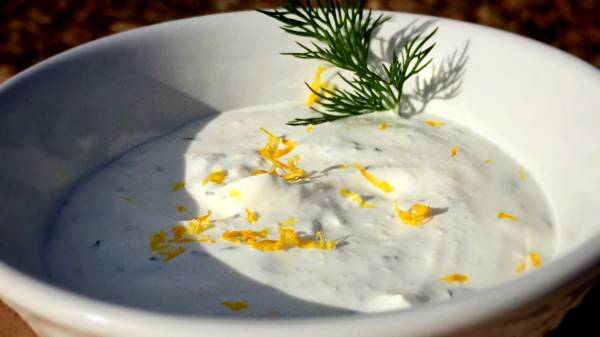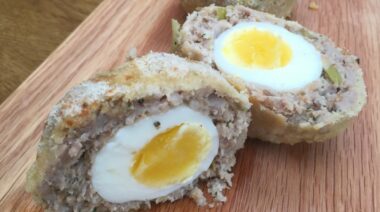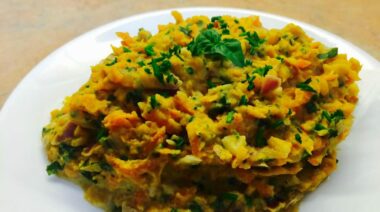Most of us consider salad to be the ultimate healthy meal. But beware: eating salads won’t help you reach your nutritional goals if you add dressings that are loaded with unhealthy oils and artificial sugars. Even those tasty salad dressings with labels like “nutritious” and “light” are filled with empty calories.
When it comes to salad dressings, think homemade, natural, and simple. Remember, the more you monitor the ingredients in your meals, the more control you have over your body’s performance. The two recipes I’ve included below pack in some extra protein and are also easy for your body to assimilate, making them a perfect choice for pre- or post-workout meals.
Healthy Salads Have Layers
Before we think about dressings, let’s go over some salad basics. The first step to a healthy salad is to layer it well:
- Start off with a good mix of nutrient-dense greens, such as baby kale or baby spinach (the baby leaf options contain more nutrients and don’t require chopping).
- Add a rainbow of veggies. Chop up some bell peppers, green onions, carrots, beets, and cucumbers and toss them in.
- Complete the meal with a protein of your choice. Lean proteins like grilled chicken or fish create a perfect post-workout meal. If you need a vegetarian or vegan option, add tofu, along with some chopped almonds or pepitas for extra crunch.
High-Quality Ingredients Support Performance
Now choose a dressing that compliments the flavors of the salad without destroying the nutritional goodness you’ve just created. Below are two healthier versions of the typical store-bought dressings you may find lurking in your fridge. Opt for these homemade dressings to cut down on added sugars, preservatives, and excess fats.
The first option is a vinaigrette dressing. Lemon juice and apple cider vinegar provide the acidity. In addition, the antibacterial properties of apple cider vinegar aids digestion,1 and has been shown to improve insulin sensitivity.2 I’ve used olive oil as the base for this recipe, but grape seed oil is another good choice.
The second recipe is a substitution for the all-American favorite, ranch dressing. Fresh dill delivers that classic ranch flavor, while Greek yogurt replaces high-fat options like buttermilk or mayonnaise. The yogurt also provides extra protein, making this a perfect dressing for a post-workout salad.
These homemade dressings are ideal to have on hand for meals throughout the week. And as an added bonus, they can also be used as marinades or dipping sauces.
Lemon Basil Vinaigrette
This light vinaigrette uses apple cider vinegar and lemon juice for acidity.
Yield: ⅔ cup
Serving size: Approximately 2 Tablespoons
Prep time: 10 minutes
Ingredients:
- 2 Tablespoons apple cider vinegar
- 1 Tablespoon freshly squeezed lemon juice
- ½ teaspoon grated lemon zest
- ½ teaspoon Dijon mustard
- ½ teaspoon finely chopped garlic
- ¾ teaspoon finely chopped basil
- ½ teaspoon salt
- ¼ teaspoon ground black pepper
- Pinch of sugar
- ½ cup extra virgin olive oil
Method:
- In a small bowl, whisk together everything except the olive oil.
- Continue whisking while slowly pouring in olive oil.
- Serve over salad greens.
Creamy Dill Dressing

Greek yogurt provides protein without excess fat and fillers.
Yield: ½ cup
Serving size: Approximately 2 Tablespoons
Prep time: 10 minutes
Ingredients:
- ½ cup plain Greek yogurt
- 1 teaspoon chopped dill
- ½ teaspoon garlic powder
- 1 teaspoon grated Parmesan cheese
- ¼ teaspoon salt
- ⅛ teaspoon ground black pepper
- ½ teaspoon lemon zest
- ¼ teaspoon lemon juice
- ¼ teaspoon onion powder
Method:
- In a small bowl, combine all ingredients.
- Whisk together to thoroughly combine.
- Serve over salad or as a dip for crudité.
You’ll Also Enjoy:
- 2 Healthy Dressings That Won’t Ruin Your Vegetables
- Want to Cut Down Recovery Time? Eat More Plants
- 5 Simple Ways for Meat Lovers to Eat More Vegetables
- New on Pulse Beat Fit Right Now
References:
1. Jung A. “13+ health benefits of apple cider vinegar.”
2. Johnston CS, Kim CM, Buller AJ. “Vinegar improves insulin sensitivity to a high-carbohystrate meal in subjects with insulin resistance or Type 2 Diabetes.” Diabetes Care 27 (2004): 281-282.
Photos courtesy of Kristina Goldman.






